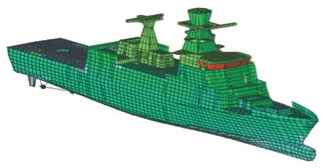Diseño de embarcaciones de alto desempeño usando Simulaciones
DOI:
https://doi.org/10.25043/19098642.21Palabras clave:
CFD, diseño de embarcaciones, simulación, análisis estructuralResumen
El diseño basado en simulaciones crecientemente está remplazando al diseño basado en la experiencia. Este trabajo presenta una visión general de las técnicas empleadas actualmente en prácticas industriales avanzadas, con particular énfasis en el diseño de buques militares. El trabajo cubre los aspectos básicos e ilustra el estado del arte con aplicaciones tomadas de la experiencia del Germanischer Lloyd.
Descargas
Referencias bibliográficas
ASMUSSEN, I.; MUMM, H. Ship vibration, GL technology, Germanischer Lloyd, Hamburg, http://www.gl-group.com/brochurepdf/0E094.pdf. 2001.
BERTRAM, V.; COUSER, P. CFD possibilities and practice, The Naval Architect, September 2007, pp.137-147 2007.
BERTRAM, V.; EL MOCTAR, O.M.; JUNALIK, B.; NUSSER, S. Fire and ventilation simulations for ship compartments, 4th Int. Conf. High-Performance Marine Vehicles (HIPER), Rome, pp.5-17. 2004.
CABOS, C.; EISEN, H.; KRÖMER, M. GL.ShipLoad: An Integrated Load Generation Tool for FE Analysis, 5th Int. Conf. Computer and IT Applications to the Maritime Industries, Leiden, www.compit.info. 2006.
CABOS, C.; JOKAT, J. Computation of structure-borne noise propagation in ship structures using noise-FEM, 7th Int. Symp. Practical Design of Ships and Mobile Units (PRADS), The Hague, pp.927-934. 1998.
CABOS, C.; WORMS, C.; JOKAT, J. Application of an energy finite element method to the prediction of structure borne sound propagation in ships, Int. Congr. Noise Control Engineering, The Hague. 2001.
EL MOCTAR, O.M. Computation of slamming and global loads for structural design using RANSE, 8th Num. Towing Tank Symp. (NuTTS), Varna. 2005.
EL MOCTAR, O.M. How to avoid or minimize rudder cavitation, 10th Num. Towing Tank Symp. (NuTTS), Hamburg. 2007. EL MOCTAR, O.M.; BERTRAM, V. Computation of viscous flow around fast ship superstructures, 24th Symp. Naval Hydrodyn., Fukuoka. 2002.
FACH, K.; BERTRAM, V. High-performance simulations for high-performance ships, 5th Int. Conf. High-Performance Marine Vehicles (HIPER), Launceston, 2006, pp.455-465. 2006.
GL. Recommendations for preventive measures to avoid or minimize rudder cavitation, Germanischer Lloyd, Hamburg. 2005.
IMO. Interim guidelines for evacuation analyses for new and existing passenger craft, MSC/Circ.1033, International Maritime Organization 2002.
JUNGLEWITZ, A.; EL MOCTAR, O.M. Numerical analysis of the steering capability of a podded drive, Ship Technology Research 51/3, pp.134-145. 2004.
MEYER-KÖNIG, T.; VALANTO, P.; POVEL, D. Implementing ship motion in AENEAS - Model development and first results, 3rd Int. Conf. Pedestrian and Evacuation Dynamics, Vienna. 2005.
OBERHAGEMANN, J.; EL MOCTAR, O.; HOLTMANN, M.; SCHELLIN, T.; BERTRAM, V.; KIM, D.W. Numerical simulation of stern slamming and whipping, 11th Numerical Towing Tank Symp., Brest. 2008.
PETERSEN, U.; MEYER-KÖNIG, T.; POVEL, D. Optimising boarding and de-boarding processes with AENEAS, 7th Int. Conf. Fast Sea Transportation FAST, Ischia, pp.9-16. 2003.
PETERSEN, U.; VOELKER, J. Deviating from the rules – ways to demonstrate an equiva¬lent level of safety, World Maritime Technology Conf., San Francisco. 2003.
WILKEN, M.; CABOS, C.; SEMRAU, S.; WORMS, C.; JOKAT, J. Prediction and measurement of structure-borne sound propagation in a full scale deckhouse-mock-up, 9th Int. Symp. Practical Design of Ships and Mobile Units (PRADS), Lübeck-Travemünde, pp.653-659. 2004.
ZHANG, L.; EGGE, E.D.; BRUHNS, H. Approval procedure concept for alternative arrangements, 3rd Int. Conf. Collision and Grounding of Ships (ICCGS), Tokyo, pp. 87-96. 2004.

Descargas
Publicado
Cómo citar
Número
Sección
Licencia
The authors who publish in this Journal certify that:
- The work submitted for publication in The Ship Science and Technology journal, was written by the author, given that its content is the product of his/her direct intellectual contribution.
- All data and references to material already published are duly identified with their respective credits and are included in the bibliographic notes and quotations highlighted as such.
- All materials submitted for publication are completely free of copyrights; consequently, the author accepts responsibility for any lawsuit or claim related with Intellectual Property Rights thereof, Exonerating of responsibility to The Science and Technology for the Development of Naval, Maritime, and Riverine Industry Corporation, COTECMAR.
- In the event that the article is chosen for publication by The Ship Science and Technology journal, the author state that he/she totally transfers reproduction rights of such to The Science and Technology for the Development of Naval, Maritime, and Riverine Industry Corporation, COTECMAR.
- The authors retain the copyright and transfer to COTECMAR the right of publication and reproduction of the work which will be simultaneously subject to the Creative Commons Attribution License (CC - BY), which allows the license to copy, distribute, display and represent the work and to make derivative works as long as it recognizes and cites the work in the manner specified by the author or licensor.
- For more information about the Creative Commons Attribution License (CC -BY) and his use and scope, please visit the following web page https://creativecommons.org/licenses/by-sa/4.0/legalcode








